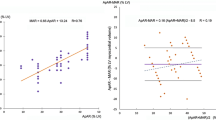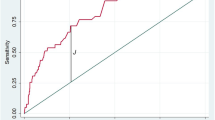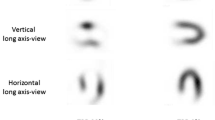Abstract
Objectives
Our study aimed to compare the area at risk (AAR) determined by single-photon emission computed tomography (SPECT) with the Bypass Angioplasty Revascularization Investigation (BARI) and modified Alberta Provincial Project for Outcome Assessment in Coronary Heart Disease (APPROACH) angiographic scores in the setting of patients undergoing coronary angioplasty for either unstable angina or an STEMI.
Background
Radionuclide myocardial perfusion imaging prior to reperfusion has classically been the most widely practised technique for assessing the AAR and has been successfully used to compare the efficacy of various reperfusion strategies in patients with an ST-segment elevation myocardial infarction (STEMI). The BARI and modified APPROACH scores are angiographic methods widely used to provide a rapid estimation of the AAR; however, they have not been directly validated with myocardial perfusion single-photon emission computed tomography (SPECT).
Methods
Fifty-five patients with no previous myocardial infarction who underwent coronary angioplasty for single-vessel disease (unstable angina: n = 25 or an STEMI: n = 30) with no evidence of collaterals (Rentrop Collateral Score <2) were included in a prospective study. In STEMI patients, the 99mTc-tetrofosmin was injected prior to opening of the occluded vessel and, in patients with unstable angina after 10-15 seconds of balloon inflation. Acquisition was performed with a dual-head gammacamera with a low-energy and high-resolution collimator. A total of 60 projections were acquired using a non-circular orbit. No attenuation or scatter correction was used. Maximal contours of hypoperfusion regions corresponding to each coronary artery occlusion were delineated over a polar map of 17 segments and compared with the estimated AAR determined by two experienced interventional cardiologists using both angiographic scores.
Results
Mean AAR percentage in SPECT was 35.0 (10.0%-56.0%). A high correlation was found between BARI and APPROACH scores (r = 0.9, P < .001). Furthermore, a high correlation was also observed between BARI versus SPECT and APPROACH versus SPECT to estimate the AAR (r = 0.9, P < .001 and r = 0.8, P < .001, respectively). Better correlations were observed when the left anterior descending artery (LAD) was revascularized (r = 0.8, P < 0.001 with BARI; r = 0.8, P = .001 with APPROACH) compared to other territories (r = 0.8, P = .001 with BARI; r = 0.7, P = .001 with APPROACH). Also, better correlations were observed in patients who underwent an elective rather than a primary percutaneous revascularization procedure.
Conclusions
In the absence of collateral flow, BARI and APPROACH scores constitute valid methods for AAR estimation in current clinical practice, with more accurate results when used for the LAD territory; both are useful not only in STEMI patients but also in patients with unstable angina.





Similar content being viewed by others
References
Lowe JE, Reimer KA, Jennings RB. Experimental infarct size as a function of the amount of myocardium at risk. Am J Pathol 1978;90:363-79.
Reimer KA, Ideker RE, Jennings RB. Effect of coronary occlusion site on ischaemic bed size and collateral blood flow in dogs. Cardiovasc Res 1981;15:668-74.
Dong J, Ndrepepa G, Schmitt C, Mehilli J, Schmieder S, Schwaiger M, et al. Early resolution of ST-segment elevation correlates with myocardial salvage assessed by Tc-99m sestamibi scintigraphy in patients with acute myocardial infarction after mechanical or thrombolytic reperfusion therapy. Circulation 2002;105:2946-9.
Ortiz-Perez JT, Meyers SN, Lee DC, Kansal P, Klocke FJ, Holly TA, et al. Angiographic estimates of myocardium at risk during acute myocardial infarction: Validation study using cardiac magnetic resonance imaging. Eur Heart J 2007;28:1750-8.
Wright J, Adriaenssens T, Dymarkowski S, Desmet W, Bogaert J. Quantification of myocardial area at risk with T2-weighted CMR: Comparison with contrast-enhanced CMR and coronary angiography. JACC Cardiovasc Imaging 2009;2:825-31.
Wijns W, Kolh P, Danchin N, Di Mario C, Falk V, Folliguet T, et al. Guidelines on myocardial revascularization: The task force on myocardial revascularization of the European Society of Cardiology (ESC) and the European Association for Cardio-Thoracic Surgery (EACTS). Eur Heart J 2010;31:2501-55.
Rentrop KP, Cohen M, Blanke H, Phillips RA. Changes in collateral channel filling immediately after controlled coronary artery occlusion by an angioplasty balloon in human subjects. J Am Coll Cardiol 1985;5:587-92.
Alderman ELMS, Michael MD. The angiography definitions of the Bypass Angioplasty Revascularization Investigation. Coron Artery Dis 1992;3:1189-208.
Brandt PWPJ, Wattie WJ. Coronary arteriography; method of presentation of the arteriogram report and a scoring system. Clin Radiol 1977;28:361-5.
Kalbfleisch H, Hort W. Quantitative study on the size of coronary artery supplying areas postmortem. Am Heart J 1977;94:183-8.
Lee JT, Ideker RE, Reimer KA. Myocardial infarct size and location in relation to the coronary vascular bed at risk in man. Circulation 1981;64:526-34.
Standardization of cardiac tomographic imaging. From the Committee on Advanced Cardiac Imaging and Technology, Council on Clinical Cardiology, American Heart Association; Cardiovascular Imaging Committee, American College of Cardiology; and Board of Directors, Cardiovascular Council, Society of Nuclear Medicine. Circulation 1992;86:338-9.
Cerqueira MD, Weissman NJ, Dilsizian V, Jacobs AK, Kaul S, Laskey WK, et al. Standardized myocardial segmentation and nomenclature for tomographic imaging of the heart: A statement for healthcare professionals from the Cardiac Imaging Committee of the Council on Clinical Cardiology of the American Heart Association. Circulation 2002;105:539-42.
O’Connor MK, Gibbons RJ, Juni JE, O’Keefe J Jr, Ali A. Quantitative myocardial SPECT for infarct sizing: Feasibility of a multicenter trial evaluated using a cardiac phantom. J Nucl Med 1995;36:1130-6.
Pereztol-Valdes O, Candell-Riera J, Santana-Boado C, Angel J, Aguade-Bruix S, Castell-Conesa J, et al. Correspondence between left ventricular 17 myocardial segments and coronary arteries. Eur Heart J 2005;26:2637-43.
Schomig A, Kastrati A, Dirschinger J, Mehilli J, Schricke U, Pache J, et al. Coronary stenting plus platelet glycoprotein IIb/IIIa blockade compared with tissue plasminogen activator in acute myocardial infarction. Stent versus thrombolysis for occluded coronary arteries in patients with Acute Myocardial Infarction Study Investigators. N Engl J Med 2000;343:385-91.
Candell-Riera J, Santana-Boado C, Castell-Conesa J, Aguade-Bruix S, Olona-Cabases M, Domingo E, et al. Culprit lesion and jeopardized myocardium: Correlation between coronary angiography and single-photon emission computed tomography. Clin Cardiol 1997;20:345-50.
Haronian HL, Remetz MS, Sinusas AJ, Baron JM, Miller HI, Cleman MW, et al. Myocardial risk area defined by technetium-99m sestamibi imaging during percutaneous transluminal coronary angioplasty: Comparison with coronary angiography. J Am Coll Cardiol 1993;22:1033-43.
Larose E, Rodes-Cabau J, Pibarot P, Rinfret S, Proulx G, Nguyen CM, et al. Predicting late myocardial recovery and outcomes in the early hours of ST-segment elevation myocardial infarction traditional measures compared with microvascular obstruction, salvaged myocardium, and necrosis characteristics by cardiovascular magnetic resonance. J Am Coll Cardiol 2010;55:2459-69.
Wu E, Ortiz JT, Tejedor P, Lee DC, Bucciarelli-Ducci C, Kansal P, et al. Infarct size by contrast enhanced cardiac magnetic resonance is a stronger predictor of outcomes than left ventricular ejection fraction or end-systolic volume index: Prospective cohort study. Heart 2008;94:730-6.
Eitel I, Desch S, Fuernau G, Hildebrand L, Gutberlet M, Schuler G, et al. Prognostic significance and determinants of myocardial salvage assessed by cardiovascular magnetic resonance in acute reperfused myocardial infarction. J Am Coll Cardiol 2010;55:2470-9.
Pereztol-Valdes O, Candell-Riera J, Oller-Martinez G, Aguade-Bruix S, Castell-Conesa J, Angel J, et al. Localization and quantification of myocardium at risk by myocardial perfusion SPECT during coronary artery occlusion. Rev Esp Cardiol 2004;57:635-43.
Faber TL, Santana CA, Garcia EV, Candell-Riera J, Folks RD, Peifer JW, et al. Three-dimensional fusion of coronary arteries with myocardial perfusion distributions: Clinical validation. J Nucl Med 2004;45:745-53.
Ceriani L, Verna E, Giovanella L, Bianchi L, Roncari G, Tarolo GL. Assessment of myocardial area at risk by technetium-99m sestamibi during coronary artery occlusion: Comparison between three tomographic methods of quantification. Eur J Nucl Med 1996;23:31-9.
Lafitte S, Higashiyama A, Masugata H, Peters B, Strachan M, Kwan OL, et al. Contrast echocardiography can assess risk area and infarct size during coronary occlusion and reperfusion: Experimental validation. J Am Coll Cardiol 2002;39:1546-54.
Aletras AH, Tilak GS, Natanzon A, Hsu LY, Gonzalez FM, Hoyt RF Jr, et al. Retrospective determination of the area at risk for reperfused acute myocardial infarction with T2-weighted cardiac magnetic resonance imaging: Histopathological and displacement encoding with stimulated echoes (DENSE) functional validations. Circulation 2006;113:1865-70.
Garcia-Dorado D, Oliveras J, Gili J, Sanz E, Perez-Villa F, Barrabes J, et al. Analysis of myocardial oedema by magnetic resonance imaging early after coronary artery occlusion with or without reperfusion. Cardiovasc Res 1993;27:1462-9.
Friedrich MG, Abdel-Aty H, Taylor A, Schulz-Menger J, Messroghli D, Dietz R. The salvaged area at risk in reperfused acute myocardial infarction as visualized by cardiovascular magnetic resonance. J Am Coll Cardiol 2008;51:1581-7.
Wince WB, Kim RJ. Molecular imaging: T2-weighted CMR of the area at risk—a risky business? Nat Rev Cardiol 2010;7:547-9.
Ortiz-Perez JT, Betriu A, Lee DC, De Caralt TM, Meyers SN, Davidson CJ, et al. Angiographic and magnetic resonance imaging evaluation of in-hospital delay in primary percutaneous intervention delivery on myocardial salvage. Am J Cardiol 2010;106:924-30.
Berry C, Kellman P, Mancini C, Chen MY, Bandettini WP, Lowrey T, et al. Magnetic resonance imaging delineates the ischemic area at risk and myocardial salvage in patients with acute myocardial infarction. Circ Cardiovasc Imaging 2010;3:527-35.
Seiler C, Kirkeeide RL, Gould KL. Measurement from arteriograms of regional myocardial bed size distal to any point in the coronary vascular tree for assessing anatomic area at risk. J Am Coll Cardiol 1993;21:783-97.
Graham MM, Faris PD, Ghali WA, Galbraith PD, Norris CM, Badry JT, et al. Validation of three myocardial jeopardy scores in a population-based cardiac catheterization cohort. Am Heart J 2001;142:254-61.
Cerqueira MD, Allman KC, Ficaro EP, Hansen CL, Nichols KJ, Thompson RC, et al. Recommendations for reducing radiation exposure in myocardial perfusion imaging. J Nucl Cardiol 2010;17:709-18.
Acknowledgment
We acknowledge Chistine O’Hara her contribution in the review of this paper.
Conflict of interest
The authors have indicated that they have no financial conflicts of interest.
Author information
Authors and Affiliations
Corresponding author
Rights and permissions
About this article
Cite this article
Rodríguez-Palomares, J.F., Alonso, A., Martí, G. et al. Quantification of myocardial area at risk in the absence of collateral flow: The validation of angiographic scores by myocardial perfusion single-photon emission computed tomography. J. Nucl. Cardiol. 20, 99–110 (2013). https://doi.org/10.1007/s12350-012-9635-5
Received:
Accepted:
Published:
Issue Date:
DOI: https://doi.org/10.1007/s12350-012-9635-5




